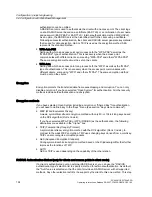
Configuration / project engineering
5.6 Configuration with Web Based Management
SCALANCE W786-xPRO
Operating Instructions, Release 08/2007, C79000-G8976-C221-02
129
uses this private key. For this function, the client must support private keys.
Note
The private key set in the ACL must also be available in the key list on the client. The
client must also use this private key for communication in Security->Basic->WLAN (the
key must be set),if an open system with encryption or shared key is used.
The private key is used on this connection for the transferred unicast packets intended for
the wireless client.
All multicast and broadcast packets are transferred with the public key set on the access
point. The wireless client entered in the ACL list must therefore also enter this public key
at the same location in its key list as the access point.
Example
In its cell, an access point uses the shared key setting with a 128-bit public key (default key
1) for encryption of the data traffic.
All wireless clients that register at this access point, require this public key at position 1 in
their key list for communication.
If access for certain wireless clients is now restricted by the ACL list of the access point on
the basis of a private key, the private key must first be stored in the key list of the access
point and the appropriate wireless clients.
The next step is to enter the MAC addresses of these wireless clients in the ACL list of the
access point and to assign the private key. If it is intended that these wireless clients should
continue communication, the private key must be set on the wireless client directly under
Security->Basic->WLAN and used for the encryption. Otherwise the clients could receive
broadband or multicast packets, but no longer be addressed directly with unicast packets.
See also
CLI
\
SECURITY
\
ACL
\
WLAN1 (or
\
WLAN2 or
\
WLAN3) menu command (Page 201)
5.6.5.5
RADIUS Server menu command
Note
The "RADIUS" menu command is available only in access point mode.
Authentication over an external server
The concept of RADIUS is based on an external authentication server. A client can only
access the network after the access point has verified the logon data of the client with the
authentication server. Both the client and the authentication server must support the EAP
protocol (Extensive Authentication Protocol). The SCALANCE W-700 supports the external
authentication mechanisms EAP-TLS, EAP-TTLS and PEAP.
















































